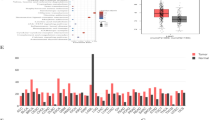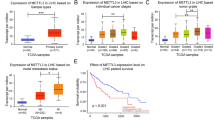Abstract
Comprehensive analysis of the expression and probable function of LSM2 in Live hepatocellular carcinoma (LIHC), and validation via in vitro experiments. Integrated use of database resources to examine the differential expression, survival prognosis, clinicopathological characteristics, and functional enrichment of LSM2 in LIHC. The expression level of LSM2 in LIHC tissues and adjacent tissues was proven via immunohistochemical staining. The biological function of LSM2 in LIHC was detected by cell proliferation, cell cloning, cell scratch, cell migration, and invasion experiments in vitro. TIMER 2.0 and GEPIA indicated that LSM2 was highly expressed in cancers and was strongly associated with survival rates in LIHC, cholangiocarcinoma, breast cancer, and renal clear cell carcinoma. LSM2 was highly expressed in LIHC, which was closely associated to the clinicopathological characteristics of patients, and the overall survival rate and disease-free survival rate of patients with high expression of LSM2 were lower than those with low expression of LSM2. Functional enrichment results revealed that LSM2 was involved to ribosome formation, DNA replication, cell cycle, metabolic processes, JAK-STAT signaling pathways, and FoxO signaling pathways. Knockdown of LSM2 inhibited the proliferation, migration, and invasion of LIHC cells in vitro experiments. LSM2 was highly expressed in LIHC and was related to a poor prognosis. Knockdown of LSM2 could inhibit the proliferation, migration, and invasion of LIHC cells.






Similar content being viewed by others
Data availability
The datasets generated during and analysed during the current study are available from the corresponding author on reasonable request.
References
Dasgupta P, Henshaw C, Youlden DR, et al. Global trends in incidence rates of primary adult liver cancers: A systematic review and meta-analysis. Front Oncol. 2020;10:171. https://doi.org/10.3389/fonc.
Lee GC, Ferrone CR, Vagefi PA, et al. Surgical resection versus ablation for early-stage hepatocellular carcinoma: A retrospective cohort analysis. Am J Sur. 2019;218(1):157–63. https://doi.org/10.1016/j.amjsurg.
Wang H, Li W. Recent update on comprehensive therapy for advanced hepatocellular carcinoma. World J Gastrointest Oncol. 2021;13(8):845–55. https://doi.org/10.4251/wjgo.
Huang X, Liu S, Wu L, et al. High throughput single cell rna sequencing, bioinformatics analysis and applications. Adv Exp Med Biol. 2018;1068:33–43. https://doi.org/10.1007/978-981-13-0502-3_4.
Li C, Jiang W, Xu Y. Omics and bioinformatics: time for new data analysis approaches? OMICS. 2017;21(12):749. https://doi.org/10.1089/omi.2017.0120.
Saadoune C, Nouadi B, Hamdaoui H, et al. Multiple myeloma: bioinformatic analysis for identification of key genes and pathways. Bioinform Biol Insights. 2022;16:11779322221115544. https://doi.org/10.1177/11779322221115545.
Lekontseva NV, Stolboushkina EA, Nikulin AD. Diversity of LSM family proteins: Similarities and differences. Biochemistry (Mosc). 2021;86(Suppl 1):S38–49. https://doi.org/10.1134/S0006297921140042.
Bertram K, Agafonov DE, Dybkov O, et al. Cryo-EM structure of a pre-catalytic human spliceosome primed for activation. Cell. 2017;170(4):701-713e11. https://doi.org/10.1016/j.cell.2017.07.011.
Agafonov DE, Kastner B, Dybkov O, et al. Molecular architecture of the human U4/U6. U5 tri-snRNP. Science. 2016;351(6280):1416–20. https://doi.org/10.1126/science.aad2085.
Rahman N, Sun J, Li Z, et al. The cytoplasmic LSm1-7 and nuclear LSm2-8 complexes exert opposite effects on Hepatitis B virus biosynthesis and interferon responses. Front Immunol. 2022;13:970130. https://doi.org/10.3389/fimmu.2022.970130.
Liu J, Gu L, Zhang D, et al. Determining the prognostic value of spliceosome-related genes in hepatocellular carcinoma patients. Front Mol Biosci. 2022;9:759792. https://doi.org/10.3389/fmolb.2022.759792.
Zhuang H, Chen B, Tang C, et al. Identification of LSM family members as novel unfavorable biomarkers in hepatocellular carcinoma. Front Oncol. 2022;12:871771. https://doi.org/10.3389/fonc.2022.871771.
Li T, Fu J, Zeng Z, et al. TIMER2.0 for analysis of tumor-infiltrating immune cells. Nucleic Acids Res. 2020;48(W1):W509–14. https://doi.org/10.1093/nar/gkaa407.
Li T, Fan J, Wang B, et al. TIMER: A web server for comprehensive analysis of tumor-infiltrating immune cells. Cancer Res. 2017;77(21):e108–10. https://doi.org/10.1158/0008-5472.CAN-17-0307.
Chandrashekar DS, Karthikeyan SK, Korla PK, et al. UALCAN: An update to the integrated cancer data analysis platform. Neoplasia. 2022;25:18–27. https://doi.org/10.1016/j.neo.2022.01.001.
Li C, Tang Z, Zhang W, et al. GEPIA2021: integrating multiple deconvolution-based analysis into GEPIA. Nucleic Acids Res. 2021;49(W1):W242–6. https://doi.org/10.1093/nar/gkab418.
Vasaikar SV, Straub P, Wang J, et al. LinkedOmics: analyzing multi-omics data within and across 32 cancer types. Nucleic Acids Res. 2018;46(D1):D956–63. https://doi.org/10.1093/nar/gkx1090.
Perea-Resa C, Hernandez-Verdeja T, Lopez-Cobollo R, et al. LSM proteins provide accurate splicing and decay of selected transcripts to ensure normal Arabidopsis development. Plant Cell. 2012;24(12):4930–47. https://doi.org/10.1105/tpc.112.103697.
Spiller MP, Reijns MA, Beggs JD. Requirements for nuclear localization of the Lsm2-8p complex and competition between nuclear and cytoplasmic Lsm complexes. J Cell Sci. 2007;120(Pt 24):4310–20. https://doi.org/10.1242/jcs.019943.
Weichenrieder O. RNA binding by Hfq and ring-forming (L)Sm proteins: a trade-off between optimal sequence readout and RNA backbone conformation. RNA Biol. 2014;11(5):537–49. https://doi.org/10.4161/rna.29144.
Chen L, Roake CM, Freund A, et al. An activity switch in human telomerase based on RNA conformation and shaped by TCAB1. Cell. 2018;174(1):218-230e13. https://doi.org/10.1016/j.cell.2018.04.039.
Yang Y, Huang T, Fan Y, et al. Significance of spliceosome-related genes in the prediction of prognosis and treatment strategies for lung adenocarcinoma. Biomed Res Int. 2022;2022:1753563. https://doi.org/10.1155/2022/1753563.
Tang W, Kannan R, Blanchette M, et al. Telomerase RNA biogenesis involves sequential binding by Sm and Lsm complexes. Nature. 2012;484(7393):260–4. https://doi.org/10.1038/nature10924.
Collopy LC, Ware TL, Goncalves T, et al. LARP7 family proteins have conserved function in telomerase assembly. Nat Commun. 2018;9(1):557. https://doi.org/10.1038/s41467-017-02296-4.
Ta HDK, Wang WJ, Phan NN, et al. Potential therapeutic and prognostic values of LSM family genes in breast cancer. Cancers (Basel). 2021;13(19):4902. https://doi.org/10.3390/cancers13194902.
Sun X, Zhang J, Xiao C, et al. Expression profile and prognostic values of LSM family in skin cutaneous melanoma. BMC Med Genomics. 2022;15(1):238. https://doi.org/10.1186/s12920-022-01395-6.
Chen Z, Han C, Zhou X, et al. Prognostic value and potential molecular mechanism of the like-Sm gene family in early-stage pancreatic ductal adenocarcinoma. Transl Cancer Res. 2021;10(4):1744–60. https://doi.org/10.21037/tcr-20-3056.
Little EC, Camp ER, Wang C, et al. The CaSm (LSm1) oncogene promotes transformation, chemoresistance and metastasis of pancreatic cancer cells. Oncogenesis. 2016;5(1):e182. https://doi.org/10.1038/oncsis.2015.45.
Chen L, Lin YH, Liu GQ, et al. Clinical significance and potential role of LSM4 overexpression in hepatocellular carcinoma: An integrated analysis based on multiple databases. Front Genet. 2021;12:804916. https://doi.org/10.3389/fgene.2021.804916.
Funding
This work was supported by the National Natural Science Foundation of China (NSFC, No. 82160517), The Guangxi Natural Science Foundation (2023GXNSFAA026081), Thousands of Young and Middle-aged Backbone Teachers in Guangxi Colleges and Universities Training Plan, and Guangxi Medical and Health Key Discipline construction project.
Author information
Authors and Affiliations
Contributions
All authors contributed to the study conception and design. Material preparation, data collection and analysis were performed by Haitao Huang, Jiahui Wang, Tingting Jiang, Nannan Zeng and Qi Wang. Yulin He and Yali Zhou directed the study and modified the article. The first draft of the manuscript was written by Peifang Qin and all authors commented on previous versions of the manuscript. All authors read and approved the final manuscript.
Corresponding authors
Ethics declarations
Conflict of interest
The authors have no relevant financial or non-financial interests to disclose.
Additional information
Publisher's Note
Springer Nature remains neutral with regard to jurisdictional claims in published maps and institutional affiliations.
Rights and permissions
Springer Nature or its licensor (e.g. a society or other partner) holds exclusive rights to this article under a publishing agreement with the author(s) or other rightsholder(s); author self-archiving of the accepted manuscript version of this article is solely governed by the terms of such publishing agreement and applicable law.
About this article
Cite this article
Qin, P., Huang, H., Wang, J. et al. The mechanism of LSM2 in the progression of live hepatocellular carcinoma was analyzed based on bioinformatics. Med Oncol 40, 276 (2023). https://doi.org/10.1007/s12032-023-02152-0
Received:
Accepted:
Published:
DOI: https://doi.org/10.1007/s12032-023-02152-0




